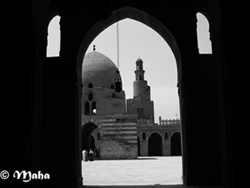Islamic architecture is not concerned about the form of buildings only. Islamic architecture signifies a process where all the phases and aspects are equally important. It is almost impossible to identify a phase or an aspect in that process and consider it more important than the others.
The Islamic architecture process starts with having a proper understanding and vision which leads to making a right intention. It continues with the planning, designing and building stages, and ends with attaining the net results and how people make use of and benefit from them. Islamic architecture is a fine blend of all these factors which are interwoven with the treads of the belief system, principles, teachings and values of Islam.
It goes without saying, therefore, that without Islam there can be no Islamic architecture. Likewise, without true Muslims who in their thoughts, actions and words epitomize the total message of Islam, there can be no Islamic architecture either. Islamic architecture is a framework for the implementation of Islam, a framework which exists in order to facilitate, encourage and promote such an implementation. Hence, no properly perceiving, creating, comprehending, studying or even using Islamic architecture can be possible in isolation from the total framework of Islam: its comprehensive worldview, ethos, doctrines, laws, practices, genesis and history. Any attempt or method that defies this rational principle is bound to end up in a failure generating in the process sets of errors and misconceptions. Indeed, the existing studies on Islamic architecture, by Muslim and non-Muslim scholars alike, and the ways in which Islamic architecture is taught and practiced today, are the best testimony to the confusion that surrounds the theme of Islamic architecture, as both a concept and sensory reality.
Prior to the colonization era, Islamic architecture was an integral and spontaneous segment of the Islamic reality, just like any other cultural and civilizational aspect of Islam as an all-inclusive divine inspiration and guidance. People did not even bother to call it as such (raging debates as to the meaning of “Islamic” and “Muslim” architecture and their similarities and differences, denote a novel phenomenon). Islamic architecture, or the ways people perceived, planned, designed, built and used buildings, was regarded as an indispensable part of an Islamic lifestyle that the Islamic perceptions of life and its myriad conceptual and sensory realities have been shaping for centuries. Truly, Islamic ways of designing and making buildings were seen as that lifestyle itself which in art and architecture took on some of the most expressive forms. The world of Islamic architecture was both the solemn identity and testimony of Islam and the true record of the life of Muslims and their civilizational awareness and achievements.
However, following the painful colonization era and its equally painful aftermath, Islamic architecture, just like a majority of the components of Islamic culture and civilization, was both distorted and virtually lost. Now when the Muslims are increasingly experiencing an Islamization awakening, the topic of Islamic architecture is being gradually resurrected too. Although the process is very sluggish, there are many signs on the horizon that inspire, encourage and breed confidence though. In order to expedite and give more sense to the process of reviving, revitalizing and Islamizing the architecture of Muslims today, the following observations and suggestions could be taken into account:
Reviving Islamic architecture is an extremely serious and demanding task. It requires major contributions and high-spirited concerted efforts of many parties from across the wide spectrum of society: government, educators, practitioners, professional bodies, NGOs, members of the business community, students and the general public. Certainly, relevant governmental departments, colleges and universities, private architectural firms and institutions are identified as the most relevant agencies and their people as the most important protagonists in spearheading and managing the Islamization of the architecture project. The responsibilities of these parties are the biggest on account of their roles in society. It follows that in case of failure, especially if such happens due to deliberate mediocrity, lack of interest and apathy, their share of blame will be the biggest one as well.
Defining and clarifying the necessary concepts and terminology such as “Islamic and Muslim architecture”, “Muslim architect”, “Islamic aesthetics”, “Islamic built environment”, “Islam and building”, “the Qur’an and the Prophet’s sunnah as the sources of Islamic architecture”, “Islam and the environment”, “ihsan, itqan or excellence”, “man as khalifah or the vicegerent on earth”, “Islam as a comprehensive way of life”, “Islam as the final and universal revelation”, “Islam and culture”, “Islam and civilization”, “Islam and society”, “Islam and history”, etc. A great many problems in the Muslim world today stem from a lack of understanding of some fundamental religious and civilizational concepts and ideas and how they are related to each other.
Developing a comprehensive code of conduct for Muslim architects based on general Islamic ethics and teachings. It can be called “Islamic architectural ethics”.
Expounding and invalidating the popular errors and misconceptions about all the aspects of Islamic architecture. The causes of such errors and misconceptions are to be carefully investigated so that the conditions conducive to breeding confusion and misunderstanding towards Islamic architecture are forever done away with.
History of Islamic architecture, commencing with the time of Prophet Muhammad (pbuh) till the present, to be critically surveyed and examined. This is so because in order to properly diagnose the present predicaments plaguing Islamic architecture and to be able to chart a better future course with regard to the same, the Muslims must be acquainted with the history of their Islamic societies, in general, and the history of Islamic architecture, in particular. History of Islamic architecture is to be neither excessively venerated nor totally discarded. A middle path is thus to be pursued and adopted. History is to serve as a source for shaping a better present and for forecasting a better future. Indeed, ignorance about history presages ignorance about the present and doubting and insecurity about the future. Moreover, ignoring one’s history portends compromising one’s identity which in turn sets in motion forfeiting one’s chances of having an impact on what happens around and to one’s self. It’s no wonder then that the colonizers of the Muslim lands sought out most to discredit much of Islamic history and to keep its peoples either ignorant or completely indifferent towards it. Finally, people alienated from their history, stripped of their intrinsic identity, are not in a position to think independently. They likewise lack a disposition or penchant to lead with poise. Following and imitating others, due to the inferiority complex deeply embedded in their minds and souls, is everything they know. Genuine inventiveness, creativity and courage have long since been removed from their phrase book.
Developing and advancing an Islamic architectural theory based on the most authentic sources of Islam: the Qur’an and sunnah, i.e., revelation.
Studying and paying due respect and appreciation to all the Muslims who excelled in architecture from the dawn of Islam till the present. The roles, reputations and contributions of those persons to society, in their respective local, regional and international contexts, are to represent the crux of this type of studies.
Comparative studies between Islamic architecture and other architectural systems and theories to be undertaken. Unifying and diverging points to be clearly spelled out and scrutinized.
Since the religion of Islam is the foundation and moral fiber of Islamic culture and civilization — including architecture — Islam likewise is to be the foundation and moral fiber of Muslim educational systems. It is only with a genuine Islamic mindset, passion and purpose that Islamic culture and civilization — including architecture — can be revitalized and restored. Thus, Muslim educational systems must aim to produce generations whose members will be acquainted with, feel affection for, practice, care and live for Islam: its ideology, peoples, history, culture and civilization. Only in such a dynamic, conducive and engaging intellectual environment, genuine Islamic architecture is, and can be, taught and learned. Islamic education must produce honorable, moral and visionary men and women, rather than materialistic, disoriented and superficially cultured professionals and citizens.
Encouraging, facilitating and supervising a quality research culture on various issues in relation to the theme of Islamic architecture. This is in order to significantly enrich libraries and bookshops with genuine references on the subject in question so that propagating, teaching and practicing Islamic architecture becomes a viable proposition. The problems of Muslims today, primarily, rest at the epistemological plane. The problems are related to the mind and ideas. They are about the lack of quality, not quantity.
Promoting architecture as a multidisciplinary branch of learning and a profession much wider than routinely held.
Encouraging and promoting creative, critical, global, unbiased, unprejudiced and tolerant thinking.
Advocating strict following in religion in matters where unreserved following is due, and unbound inventing in architecture where inventing and concocting are due.
Promoting the concept of unity in diversity in Islamic architecture, i.e., the unity of spiritual message, civilizational soul, identity and purpose, and the diversity of artistic and scientific styles, methods and solutions.
In Muslim colleges and universities, the Islamic worldview, the belief system, ethics and other relevant teachings and values of Islam, to be felicitously integrated into the architecture curriculum at both the theoretical and practical levels. The relevant religious and architectural technical components are to be viewed as the equivalent parts of a whole with no clear demarcation lines separating them. This way, students will have little or no reasons to develop any aversion to the notion of integration between the religion of Islam and architecture. Relevant religious components if properly integrated will not be deemed as an addendum to the existing curriculum, or as an extra burden imposed on students. Both religion and architecture will thus be seen in their true light. Islamic architecture must be presented and taught as a revolutionary world phenomenon, as universal, abiding and revealing as the standards and values that gave rise to it. True, Islamic architecture is as responsive to the climatic, geographical, cultural, economic and technological requirements as any other architectural tradition. Nevertheless, it never treats them away from exigencies of a higher order. By means of skills, creativity and imagination on the one hand, and by its distinctive combination of aesthetic and utilitarian ends, on the other, Islamic architecture never draws a wedge between man’s physical, psychological and spiritual needs. Certainly, it is for this spiritual dimension that Islamic architecture entails that Mimar Sinan (d. 1588 CE), the chief architect of the Ottoman golden age, called architecture an “estimable calling” and then said that whosoever is engaged in it must be, first of all, pious.
As regards the implementation of the Islamization of architecture project, policy-makers in particular to prepare measures and mechanisms for the implementation and to develop indicators of performance.
By: Assoc. Prof. Dr. Spahic Omer
Kulliyyah of Architecture and Environmental Design
International Islamic University Malaysia
Posted on October 1, 2012


